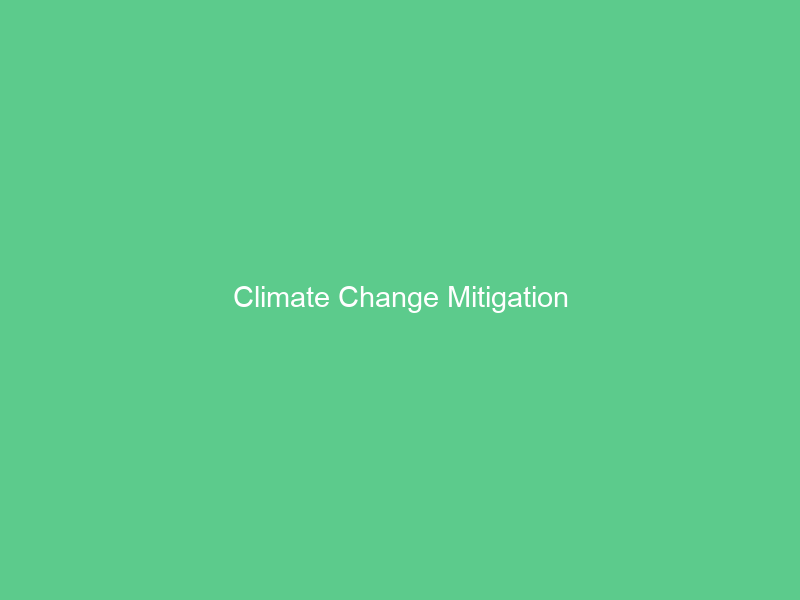Climate change mitigation refers to actions undertaken by humans that reduce human contributions to global warming by decreasing emissions of heat-trapping greenhouse gases and expanding carbon sinks (such as forests). Mitigation also includes encouraging communities to adopt cleaner energy sources and practices.
Goal of global greenhouse gas stabilization efforts is to achieve long-term balances that enable ecosystems and societies to adapt, while avoiding irreversible climate changes.
Biological Carbon Sequestration
CO2 sequestration through soil segregation is an effective and sustainable solution to reducing atmospheric CO2 concentrations, with human activities contributing to global climate changes that negatively affect societies and ecosystems alike. Sequestration could provide an affordable and sustainable solution.
Biological sequestration refers to the process of sequestering atmospheric CO2 into terrestrial ecosystems such as grassland and forest plants, soils and oceans. These natural processes serve as major carbon sinks due to their ability to absorb CO2 during photosynthesis before storing it as living and dead plant matter; their estimated abiotic carbon storage capacities reach into thousands of Pg C.
Abiotic sequestration (ABS) is an engineering process which entails the capture, liquefaction and injection of industrial CO2 into deep geological layers such as coal seams, old oil wells, stable rock formations or saline aquifers. This technology is currently under development.
Reducing Emissions
Climate change mitigation begins by decreasing emissions of heat-trapping greenhouse gases into the atmosphere. To do this, one approach is to incentivize cleaner economic activity while penalizing activities that produce large amounts of GHGs; examples of such policies would be providing incentives for renewable energy, fuel-efficient vehicles and buildings, conservation, reforestation and restoration of natural ecosystems among others.
Global energy systems could reduce emissions by 12.6 gigatonnes annually by decreasing fossil fuel use, improving energy efficiency and supporting transition to clean renewable electricity sources. Doing this would save consumers money on their electric bills while improving air quality, creating jobs and creating economic stability – among many other advantages.
Reducing short-lived climate pollutants is estimated to prevent millions of premature deaths each year from air pollution and lessen its near-term impacts, such as heat-aggravated illnesses and vector-borne diseases; food insecurity; decreased access to water sources. Restoring and conserving natural ecosystems also provides another form of climate mitigation by decreasing atmospheric carbon while creating more space for people and wildlife to cohabitate in nature.
Adaptation
Human activities are the main contributor to climate change, including emissions of heat-trapping greenhouse gases into the atmosphere (emissions) or reduced capacity of natural carbon sinks to absorb them (mitigation). These activities include fossil fuel combustion, deforestation and agricultural land use practices.
Adaptation involves anticipating the effects of climate change and taking measures to offset them, such as building defences to protect against sea-level rise or restoring wetlands to reduce flood risks or improving agricultural practices that manage droughts or heatwaves better. Adaptation also can include behavioral modifications like checking on vulnerable family members during heatwaves.
Investing in adaptation will yield multiple returns by safeguarding lives, property and infrastructure as well as natural ecosystems – as well as helping reduce poverty, increase prosperity and enhance food security. But care must be taken to avoid maladaptation where unintended consequences such as increasing risk exposure or shifting risks among sectors occur – for instance a seawall built to protect houses against rising sea levels may actually result in beach erosion – which may negate its purpose entirely.
Policy
Many policy approaches exist to incentivize actions that are cleaner and disincentives those which produce high levels of greenhouse gasses (GHGs). These policies range from economic incentives and market forces, all the way through prescriptive regulations imposed from above, all used together or individually as appropriate. All approaches don’t need to be mutually exclusive either.
Policies may also focus on conserving and restoring natural ecosystems, which act as carbon sinks to help lower atmospheric carbon. Unfortunately, however, natural ecosystems worldwide are under constant threat from development projects which reduces their effectiveness as carbon sinks.
Reducing greenhouse gas emissions requires a comprehensive set of policies that include increasing energy efficiency, investing in clean energy sources and electrification of sectors dependent on fossil fuels, among others. All such strategies should take into account the needs and concerns of low income, minority and historically underserved communities who often feel first the effects of climate change as it unfolds and are especially susceptible to its negative consequences.

